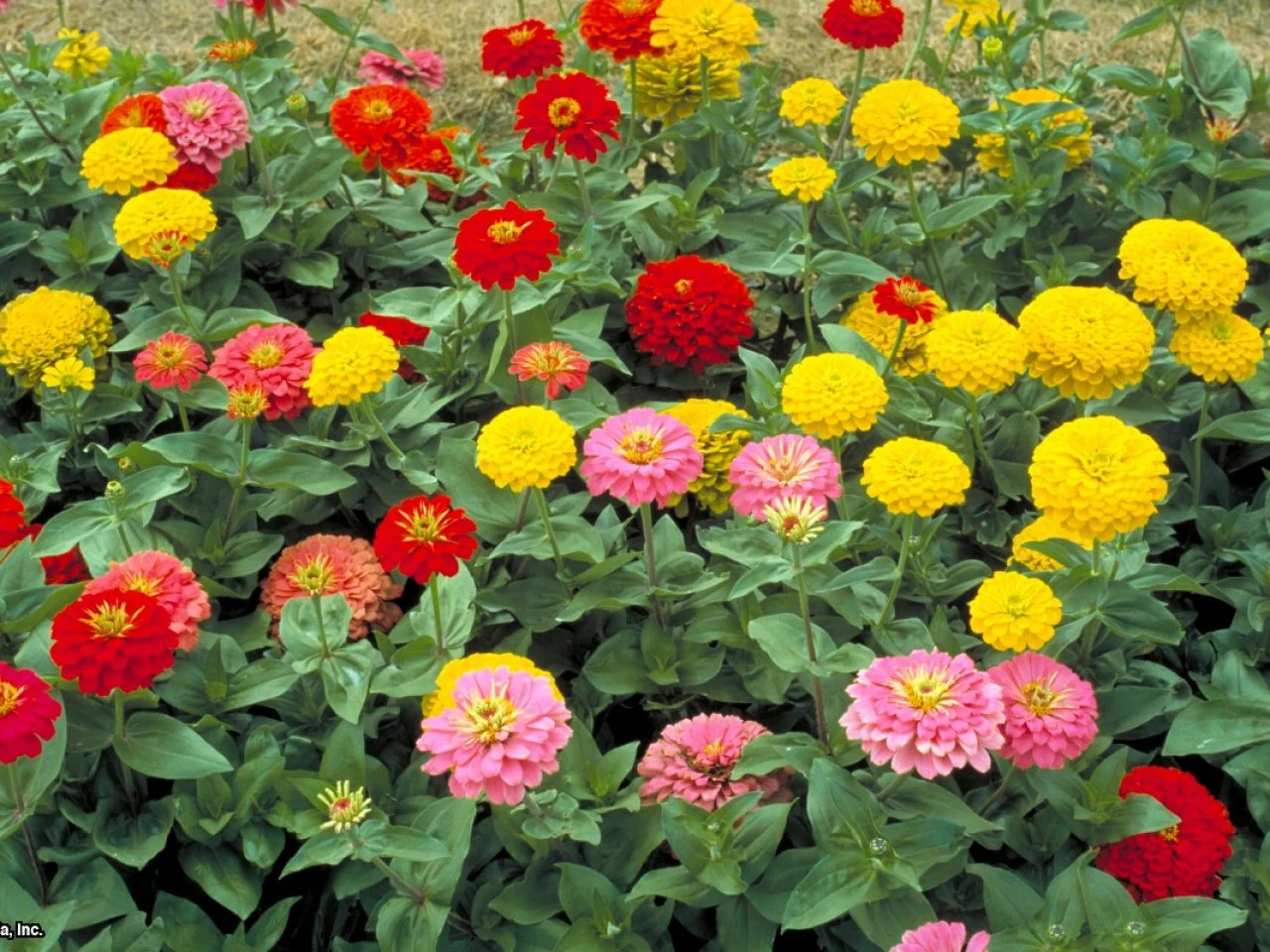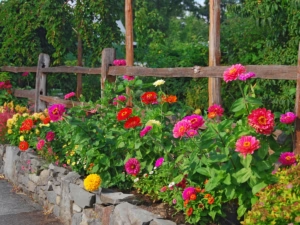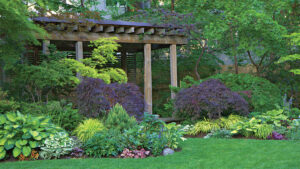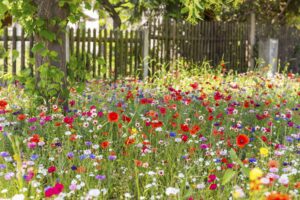10 Cozy Cosmos and Zinnia Garden Ideas for Effortless Color
When planning your garden for the season, few flower combinations offer as much bang for your buck as cosmos and zinnias. These two flowering superstars create a symphony of color with minimal effort, making them perfect for both novice gardeners and seasoned green thumbs looking to add effortless vibrancy to their outdoor spaces.
The beauty of pairing cosmos and zinnias lies in their complementary growth habits, blooming periods, and color ranges, allowing you to create stunning visual displays that last from early summer until the first frost. According to the USDA Natural Resources Conservation Service, both flowers are excellent choices for supporting local pollinators, adding ecological value to your garden while delivering spectacular beauty.
In this comprehensive guide, we’ll explore ten creative garden ideas that showcase these versatile flowering plants, providing you with inspiration, practical tips, and design principles to transform your outdoor space into a colorful haven that blooms reliably with minimal maintenance.
Understanding Cosmos and Zinnias: The Perfect Flowering Pair
Before diving into specific garden designs, it’s worth understanding why cosmos and zinnias make such excellent garden companions. These summer-blooming annuals share similar growing requirements while offering different visual characteristics that complement each other beautifully.
Cosmos (Cosmos bipinnatus and Cosmos sulphureus) feature delicate, daisy-like blooms on tall, slender stems with feathery foliage. They typically reach heights of 2-5 feet, creating a billowy, airy appearance that adds movement and vertical interest to gardens. Cosmos colors range from white and soft pink to vibrant magenta, orange, and yellow, depending on the variety.
Zinnias (Zinnia elegans), by contrast, offer bold, dahlia-like flowers on sturdy stems with broader leaves. They provide a more structured presence in the garden, ranging from compact 6-inch varieties to statuesque 4-foot specimens. Their color palette is remarkably diverse, spanning nearly every shade except true blue—from crisp whites and soft pastels to saturated reds, oranges, yellows, and unique bi-colors.
According to the USDA Plant Hardiness Zone Map, both cosmos and zinnias thrive throughout most of the United States, performing especially well in zones 3-10, though they’re grown as annuals in all but the warmest climates.
Key Characteristics Comparison
| Feature | Cosmos | Zinnias |
|---|---|---|
| Height | 18-60 inches, depending on variety | 6-48 inches, depending on variety |
| Bloom Shape | Daisy-like, open-centered | Pompom, dahlia-like, or daisy-like |
| Foliage | Finely cut, feathery | Broad, lance-shaped |
| Sun Requirements | Full sun | Full sun |
| Water Needs | Moderate to low | Moderate |
| Bloom Period | Early summer to frost | Early summer to frost |
| Deer Resistance | Moderate to good | Moderate |
Now that we understand the complementary nature of these flowering companions, let’s explore ten creative ways to incorporate them into your garden landscape for maximum impact with minimal effort.
1. The Cottage Garden Border: Nostalgic Charm with Modern Ease
Perhaps the most natural setting for cosmos and zinnias is the classic cottage garden, where their informal beauty and prolific blooming perfectly capture the essence of this beloved garden style. The cottage garden aesthetic embraces a certain controlled chaos, making it ideal for beginning gardeners since perfect spacing and pristine maintenance aren’t required.
To create your own cosmos and zinnia cottage border, select a sunny location with well-draining soil. For a truly effortless approach, prepare your soil in spring by loosening it to about 6-8 inches deep and incorporating some compost. The National Garden Bureau recommends direct sowing both cosmos and zinnia seeds after your region’s last frost date when soil temperatures have warmed to at least 60°F.
For a successful cottage border, layer your plantings with taller varieties toward the back and shorter ones in front:
- Back row: Tall cosmos varieties like ‘Sensation Mix’ (3-4 feet tall) or ‘Psyche White’ (4-5 feet)
- Middle row: Medium-height zinnias such as ‘State Fair Mix’ or ‘Benary’s Giant’ (30-36 inches)
- Front row: Compact zinnias like ‘Zahara’ series or ‘Profusion’ series (12-18 inches)
Scatter seeds in drifts rather than formal rows, mimicking how they might naturally self-sow. This creates a more authentic cottage garden appearance and requires less precision during planting. Once established, these flowering workhorses will create a continuous display of color from June through October with minimal intervention from you.
To enhance the cottage garden effect, consider adding complementary flowering companions like bachelor’s buttons (Centaurea cyanus), love-in-a-mist (Nigella damascena), or annual phlox (Phlox drummondii). These easy-growing annuals share similar cultural requirements and contribute to the informal, abundant aesthetic.
The cottage garden approach truly embodies the “effortless color” promise of cosmos and zinnias. By embracing some natural randomness and focusing on compatible plant combinations, you’ll create a display that improves as the season progresses, with plants filling in gaps and creating a tapestry of color and texture.

2. The Cutting Garden: Endless Bouquets at Your Fingertips
One of the greatest advantages of growing cosmos and zinnias is their exceptional performance as cut flowers. Both varieties actually bloom more profusely when regularly harvested, making them perfect candidates for a dedicated cutting garden that provides armloads of flowers for indoor enjoyment throughout the growing season.
According to the USDA Agricultural Research Service, regularly harvesting flowers like zinnias and cosmos not only provides material for bouquets but also promotes branching and additional bloom production, creating a beneficial cycle for both garden display and flower harvesting.
Here’s how to design an efficient cutting garden using these prolific bloomers:
Create dedicated beds in rows, much like a vegetable garden, with paths between for easy access and harvesting. Traditional cutting gardens favor functionality over ornamental display, though your cosmos and zinnias will look beautiful regardless of their arrangement.
For maximum productivity, plant your flowers in blocks by type and color, which makes harvesting more efficient and allows you to quickly gather specific colors for themed arrangements. Allow approximately 9-12 inches between zinnia plants and 12-18 inches between cosmos, depending on variety size.
Consider this selection of especially productive varieties for cutting:
Cosmos for Cutting:
- ‘Double Click’ series (double flowers in pink, white, and bicolor)
- ‘Rubenza’ (deep ruby red that fades to rose)
- ‘Cupcake’ series (unique fluted petals)
- ‘Versailles’ series (strong stems and large blooms)
Zinnias for Cutting:
- ‘Benary’s Giant’ series (massive 4-6 inch blooms on long stems)
- ‘Queen Red Lime’ and ‘Queen Lime Orange’ (unique antique colors)
- ‘Oklahoma’ series (smaller but extremely prolific flowers on long stems)
- ‘Cactus Flowered Mix’ (quilled petals for unusual texture)
For the longest vase life, harvest your cosmos and zinnias in the morning when temperatures are cool. Cut stems when flowers are almost fully open but before pollen has begun to shed. Remove all foliage that would sit below the water line in your vase, and place stems immediately in clean water.
By dedicating even a small 4′ x 8′ bed to cutting flowers, you’ll produce enough cosmos and zinnias to keep your home filled with fresh bouquets from June through October, with plenty to share with friends and neighbors.

3. The Pollinator Paradise: Supporting Biodiversity with Beauty
Beyond their ornamental value, cosmos and zinnias rank among the most pollinator-friendly annuals you can grow. Their open flower forms, abundant nectar, and pollen make them irresistible to bees, butterflies, and beneficial insects of all kinds. According to the USDA Forest Service, creating pollinator-friendly gardens not only supports important ecological functions but can increase the productivity of nearby vegetable gardens by up to 30%.
To maximize the habitat value of your cosmos and zinnia plantings, consider these design principles:
Plant in drifts of at least 3-5 square feet of a single variety. This planting style makes your garden more visible to passing pollinators and provides efficient foraging opportunities. While mixed plantings look beautiful to human eyes, blocks of single varieties are more attractive and functional for pollinators.
Include varieties with different flower forms and blooming periods to support diverse pollinator species. Single-flowered varieties generally provide better access to nectar and pollen than heavily doubled forms.
Best Cosmos for Pollinators:
- ‘Sensation’ series (classic single flowers in white, pink, and crimson)
- ‘Bright Lights’ (Cosmos sulphureus with orange-yellow blooms)
- ‘Seashells’ (unique tubular petals that butterflies love)
Best Zinnias for Pollinators:
- ‘Profusion’ series (disease-resistant with abundant single flowers)
- ‘Zinderella’ series (partially double with accessible centers)
- ‘State Fair’ (large flowers with semi-double forms)
Consider this plant association table for a comprehensive pollinator garden:
| Plant Combination | Benefits | Bloom Time | Target Pollinators |
|---|---|---|---|
| Cosmos + Zinnias + Sunflowers | Extended bloom season, varied heights | June-October | Bees, butterflies, hoverflies |
| Cosmos + Zinnias + Mexican Sunflower (Tithonia) | Heat tolerance, drought resistance | July-Frost | Monarch butterflies, native bees |
| Cosmos + Zinnias + Verbena bonariensis | Structural diversity, extended bloom | June-October | Small butterflies, bees, moths |
To further enhance your pollinator garden, incorporate a shallow water source, avoid pesticide use, and allow some areas of bare soil for ground-nesting bees. The USDA Natural Resources Conservation Service offers additional resources on creating pollinator habitat in home gardens.
By approaching your cosmos and zinnia plantings with pollinators in mind, you’ll not only create a vibrant, constantly changing garden display but also provide vital resources for the creatures that keep our ecosystem functioning.
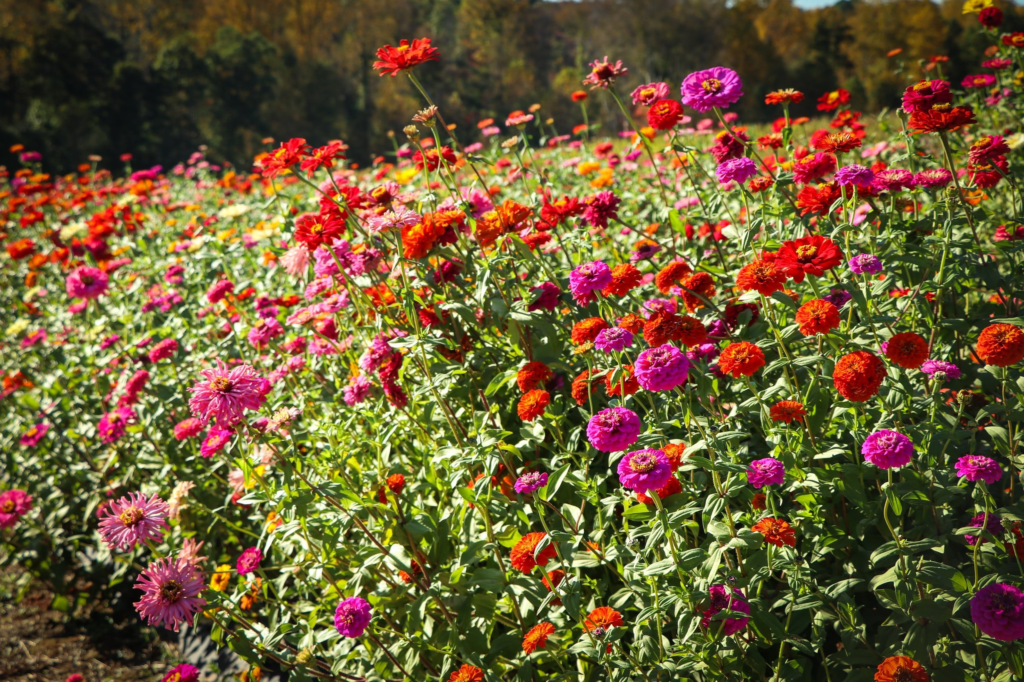
4. The Container Collection: Small-Space Solutions with Big Impact
Don’t have a large garden? No problem. Cosmos and zinnias adapt beautifully to container culture, bringing their easy-care color to patios, balconies, and even apartment windowsills. Container growing actually offers several advantages: precise control over soil quality, the ability to move plants to optimize sunlight, and enhanced visibility of these beautiful blooms.
For successful container growing, follow these guidelines:
Choose appropriately sized containers with adequate drainage. For most cosmos and zinnias, containers should be at least 10-12 inches deep and wide. Larger varieties may require pots up to 16-18 inches in diameter. Self-watering containers can be particularly helpful during hot summer weather when these plants are at their peak growth.
Use high-quality potting mix rather than garden soil, which can become compacted in containers. Look for mixes containing perlite or vermiculite for improved drainage. According to the USDA Agricultural Research Service, container-grown flowering plants benefit from soil formulated specifically for containers, as they allow for the perfect balance of moisture retention and drainage.
Select varieties suitable for container culture:
Best Cosmos for Containers:
- ‘Sonata’ series (compact 18-24″ height)
- ‘Cosmic’ series (dwarf plants under 12″)
- ‘Apollo’ series (early blooming, compact habit)
Best Zinnias for Containers:
- ‘Zahara’ series (disease-resistant and compact)
- ‘Magellan’ series (large flowers on 12-14″ plants)
- ‘Thumbelina’ (ultra-dwarf at 6″ tall)
Create visual interest by combining varieties of different heights, colors, and flower forms. The following container combinations offer season-long appeal:
- Thriller-Filler-Spiller: Use a tall cosmos as the “thriller” (center or back), surround with medium zinnias as “fillers,” and add trailing plants like calibrachoa or bacopa as “spillers” at the edges.
- Monochromatic Magic: Combine different varieties of cosmos and zinnias in the same color family (all pinks, all whites, or all oranges) for a sophisticated, cohesive look.
- Color Wheel Contrast: Pair complementary colors that sit opposite each other on the color wheel—orange zinnias with blue salvia, or purple cosmos with yellow marigolds—for maximum visual impact.
Remember that container plants typically need more frequent watering and feeding than garden plants. During peak summer growth, you may need to water daily. Apply a half-strength dose of balanced liquid fertilizer every 2-3 weeks to maintain vigor and continuous flowering.
Even a single large container of mixed cosmos and zinnias can provide months of color for minimal investment, making this approach perfect for gardening beginners or those with limited outdoor space.
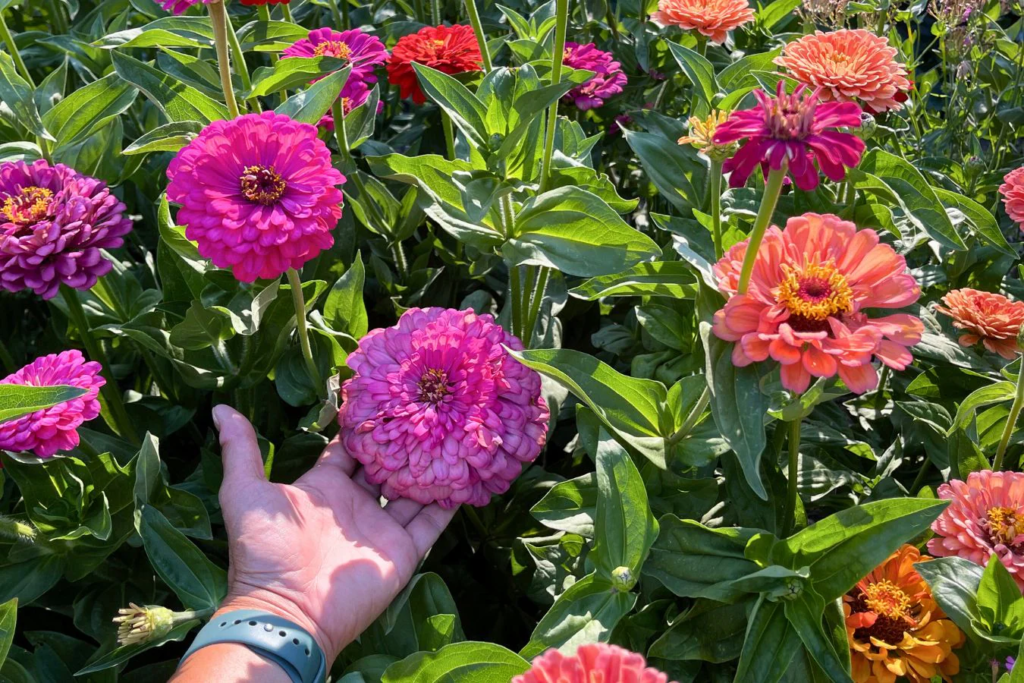
5. The Children’s Discovery Garden: Growing Young Gardeners
Few plants are better suited for introducing children to the joys of gardening than cosmos and zinnias. Their large seeds are easy for small hands to handle, they germinate quickly to maintain young attention spans, and their rapid growth provides the near-immediate gratification that children crave. The USDA Team Nutrition program recognizes the educational value of garden activities for children, noting that gardening experiences can improve children’s food choices and physical activity levels.
Here’s how to create a cosmos and zinnia garden specifically designed for young gardeners:
Designate a sunny area with good visibility from the house, ideally with paths that allow children to enter the garden and explore. Consider creative bed shapes like circles, crescents, or even letters or numbers for added educational value.
Select varieties with features that appeal to children’s senses and interests:
- Dramatic height variations, from dwarf zinnias to towering cosmos
- Bold, bright colors in the “crayon box” range
- Interesting textures and patterns, like the striped petals of ‘Peppermint Stick’ zinnias
- Flowers that attract visible wildlife like butterflies and hummingbirds
Involve children in every stage of the process, from soil preparation and seed planting to regular maintenance and flower harvesting. Create a simple planting guide with pictures rather than words for pre-readers, or help older children design their own garden layout on graph paper.
Consider adding playful elements to the garden, such as:
- A sunflower house (tall sunflowers planted in a circle) with cosmos and zinnias as “furniture”
- Stepping stones painted by the children themselves
- Simple signage created by young gardeners
- A dedicated cutting basket and child-sized gardening tools
- A weather station or bug observation area
Use the garden as a teaching tool throughout the season, incorporating lessons about:
- Plant life cycles from seed to flower to seed again
- Insect identification and pollination
- Weather patterns and their effects on plant growth
- Mathematical concepts through measuring plant height and counting flowers
- Art projects using pressed flowers or observational drawing
The USDA Farm to School Program offers additional resources for garden-based education that can be adapted for home use, helping you maximize the learning potential of your child-friendly cosmos and zinnia garden.
By engaging children in the process of growing these beginner-friendly flowers, you’ll not only create beautiful garden displays but also nurture the next generation of gardening enthusiasts and environmental stewards.
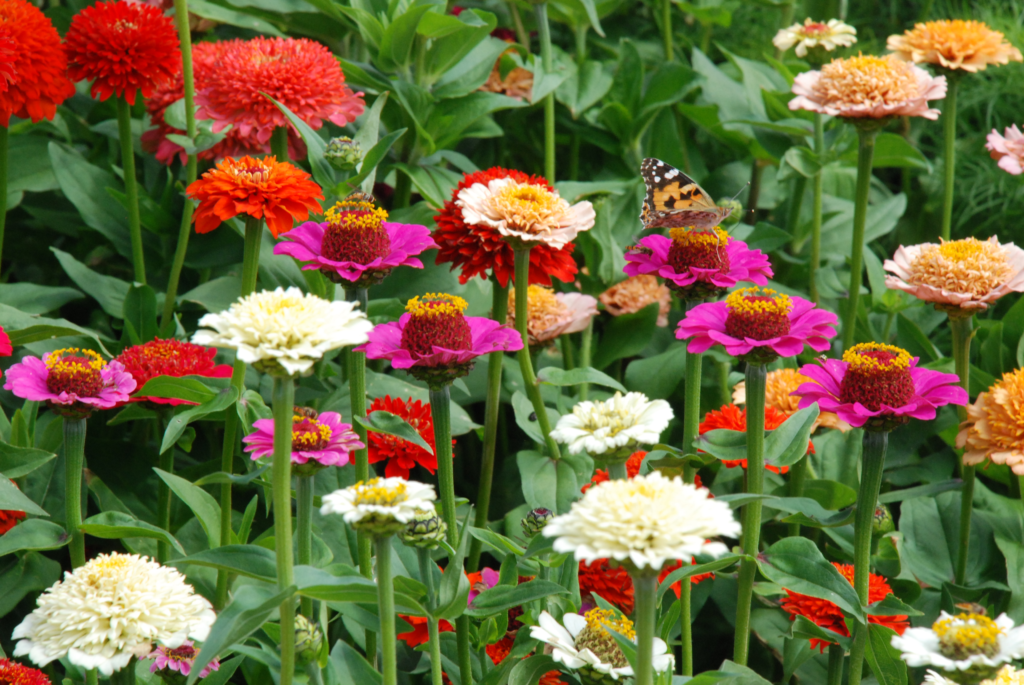
6. The Drought-Tolerant Display: Beauty with Water Wisdom
In many regions of the United States, water conservation is an increasing priority for responsible gardeners. Fortunately, both cosmos and zinnias have excellent drought tolerance once established, making them perfect candidates for water-wise gardening. Their Central American and Mexican origins have endowed them with natural adaptations to periodic dry conditions, allowing them to thrive with minimal supplemental irrigation.
The USDA Natural Resources Conservation Service promotes water-conserving landscaping principles that can be beautifully executed using cosmos and zinnias in your garden design.
To create a drought-tolerant cosmos and zinnia garden, implement these strategies:
Prepare your soil thoroughly before planting. While these flowers can tolerate poor soil, improving your soil’s structure with compost or other organic matter increases its water-holding capacity, making every drop of rain or irrigation more effective.
Choose varieties with enhanced drought tolerance:
Most Drought-Resistant Cosmos:
- Cosmos sulphureus varieties (orange cosmos)
- ‘Xanthos’ (soft yellow with excellent heat tolerance)
- ‘Sonata’ series (more compact with good drought resistance)
Most Drought-Resistant Zinnias:
- ‘Profusion’ series (exceptional heat and drought tolerance)
- ‘Zahara’ series (bred for challenging conditions)
- ‘Desert Sunset’ mix (selected for southwestern gardens)
Implement proper watering practices to develop drought tolerance:
- Water deeply but infrequently to encourage deep root development
- Apply 2-3 inches of organic mulch to conserve soil moisture and suppress weeds
- Water at the soil level rather than overhead to reduce evaporation and disease
- Gradually reduce irrigation frequency as plants establish to “train” them for drought resilience
Consider planting in a slight depression rather than a raised bed to capture natural rainfall. This technique, sometimes called a rain garden or sunken bed, allows water to collect around your plants rather than running off.
For a comprehensive drought-tolerant display, combine your cosmos and zinnias with other water-wise companions:
| Plant Combination | Water Needs | Bloom Period | Features |
|---|---|---|---|
| Cosmos + Zinnias + Gaillardia | Low | June-October | Long-blooming, heat-tolerant |
| Cosmos + Zinnias + Globe Amaranth | Low | July-Frost | Excellent for dried flowers too |
| Cosmos + Zinnias + Salvia greggii | Low | May-October | Attracts hummingbirds, fragrant foliage |
A thoughtfully designed drought-tolerant garden featuring cosmos and zinnias proves that water-wise landscaping doesn’t have to look sparse or brown. With their abundant blooms and lush growth, these flowers create vibrant displays while respecting precious water resources.
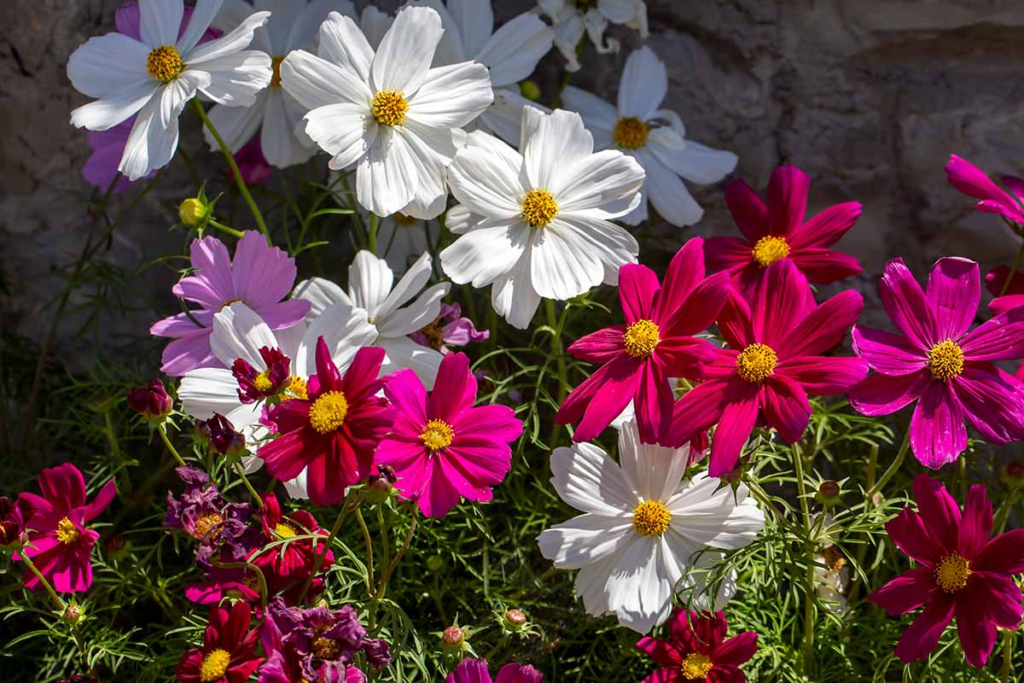
7. The Seasonal Color Transition: Spring to Fall Continuous Bloom
One of the challenges of garden design is maintaining visual interest throughout the growing season. While many gardens peak in spring or mid-summer, a well-planned cosmos and zinnia garden can provide continuous color from late spring through the first hard frost of autumn. By combining them with strategic companion plants and using succession planting techniques, you can create a garden that transitions seamlessly through the seasons.
The USDA Plant Hardiness Zone Map divides the United States into climate zones that help determine planting times. In most regions (Zones 4-9), this seasonal transition garden might unfold as follows:
Early Season (April-May): Begin with spring-flowering bulbs like tulips and daffodils. As these emerge, direct-sow your early cosmos and zinnia seeds in areas where the bulbs are growing. The emerging annual seedlings will gradually hide the fading bulb foliage.
Early Summer (June-July): As spring bloomers fade, your first cosmos and zinnias begin flowering. Choose early varieties like ‘Cosmic’ cosmos and ‘Zahara’ zinnias for this phase. Combine with early-summer perennials like salvias, coreopsis, and early echinaceas for diversity.
Mid-Summer (July-August): The main cosmos and zinnia display takes center stage. This is when your classic varieties reach their peak, creating masses of color. ‘Sensation’ cosmos and ‘State Fair’ zinnias offer classic forms and abundant blooms during this period.
Late Summer into Fall (September-Frost): As summer fades, cosmos and zinnias continue strong, often producing their most abundant blooms in September and October. Their colors complement emerging autumn tones in the landscape. Late-season companions like asters, ornamental grasses, and changing leaf colors create a rich seasonal tapestry.
To extend your display even further, implement these succession planting strategies:
- Staggered Sowing: Plant seeds in 2-3 week intervals from spring through mid-summer for continuous waves of new blooms
- Mid-Season Cut-Back: In early July, cut back about one-third of your cosmos plants by half their height to delay their peak bloom until later in the season
- Deadheading Discipline: Remove spent flowers consistently on some plants while allowing others to develop seed heads for both continued bloom and fall visual interest
- Fall Fillers: Interplant cool-season annuals like pansies or ornamental kale among your cosmos and zinnias in September to provide color as the first light frosts begin to affect your summer bloomers
By thinking of your garden as a dynamic, ever-changing display rather than a static planting, you’ll create months of continuous color that evolves with the seasons, all while maintaining the easy-care benefits that cosmos and zinnias provide.
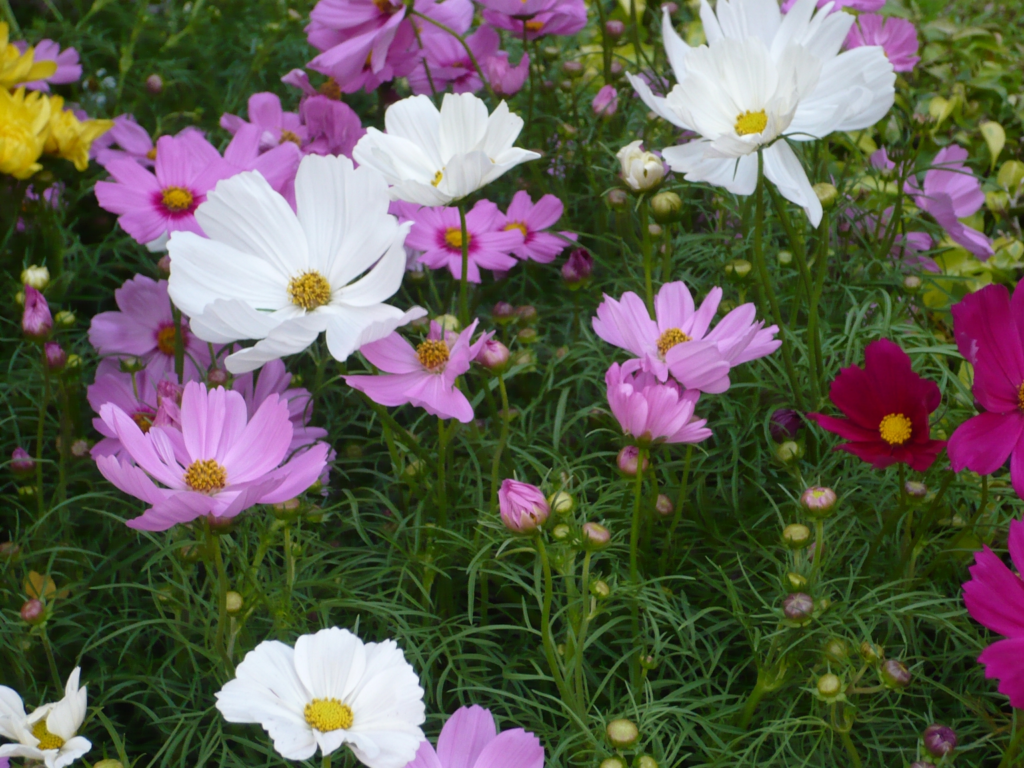
8. The Color-Themed Garden: Designing with Intention
While cosmos and zinnias are known for their diverse color range, creating a garden with a deliberate color theme can elevate your planting from simply “pretty” to truly memorable. Color-themed gardens create stronger visual impact, photograph beautifully, and often appear more sophisticated than mixed-color plantings. They also offer an opportunity to express your personal aesthetic and complement your home’s exterior.
Here are several color theme ideas using cosmos and zinnias, along with suggestions for specific varieties:
Pastel Paradise: Create a soft, romantic garden using cosmos and zinnias in blush pinks, pale yellows, lavenders, and whites. This gentle palette feels peaceful and expansive, making even small gardens seem larger.
- Cosmos: ‘Cupcake Blush,’ ‘Psyche White,’ ‘Daydream’ (pale pink with dark center)
- Zinnias: ‘Queeny Lime Blush,’ ‘Zinderella Peach,’ ‘Peppermint Stick’
- Companions: White cleome, pale blue bachelor’s buttons, silver-leaved dusty miller
Sunset Spectacular: Embrace the warm side of the color wheel with fiery oranges, reds, and yellows that capture the intensity of a summer sunset. This high-energy palette creates a festive atmosphere that pairs beautifully with southwestern or Mediterranean-style homes.
- Cosmos: ‘Bright Lights’ (orange/yellow), ‘Sulphur Cosmic’ (bright yellow)
- Zinnias: ‘Zowie Yellow Flame,’ ‘Queeny Lime Orange,’ ‘Profusion Fire’
- Companions: Black-eyed Susans, celosia, lantana
Sophisticated Monochrome: Select varieties in graduated shades of a single color for an elegant, designer look. Purple/violet themes are particularly striking and complement many landscape styles.
- Cosmos: ‘Rubenza’ (deep red that ages to rose), ‘Velouette’ (burgundy bicolor)
- Zinnias: ‘Queen Red Lime,’ ‘Benary’s Giant Wine,’ ‘Purple Prince’
- Companions: Purple basil, dark-leaved dahlias, purple fountain grass
Patriotic Display: Create an all-American red, white, and blue theme. While true blue is missing from the cosmos and zinnia palette, you can incorporate blue companions to complete the tricolor scheme.
- Cosmos: ‘Psyche White,’ ‘Sensation Crimson’
- Zinnias: ‘Polar Bear’ (white), ‘Benary’s Giant Scarlet’
- Blue companions: Blue salvia, bachelor’s buttons, blue ageratum
Whatever color theme you choose, consider these design principles for maximum impact:
- Use odd numbers of each plant grouping (3, 5, 7) for natural-looking arrangements
- Include varying heights and textures within your color scheme
- Consider the visual “weight” of different colors—whites and yellows advance visually, while deep purples and reds recede
- Incorporate foliage plants that complement your color theme (silver foliage with pastel flowers, dark foliage with bright colors)
The USDA Agricultural Research Service notes that intentional color schemes in home landscapes can increase property values and create specific psychological effects, from energizing (warm colors) to calming (cool colors), allowing you to design your outdoor space to support your desired atmosphere.
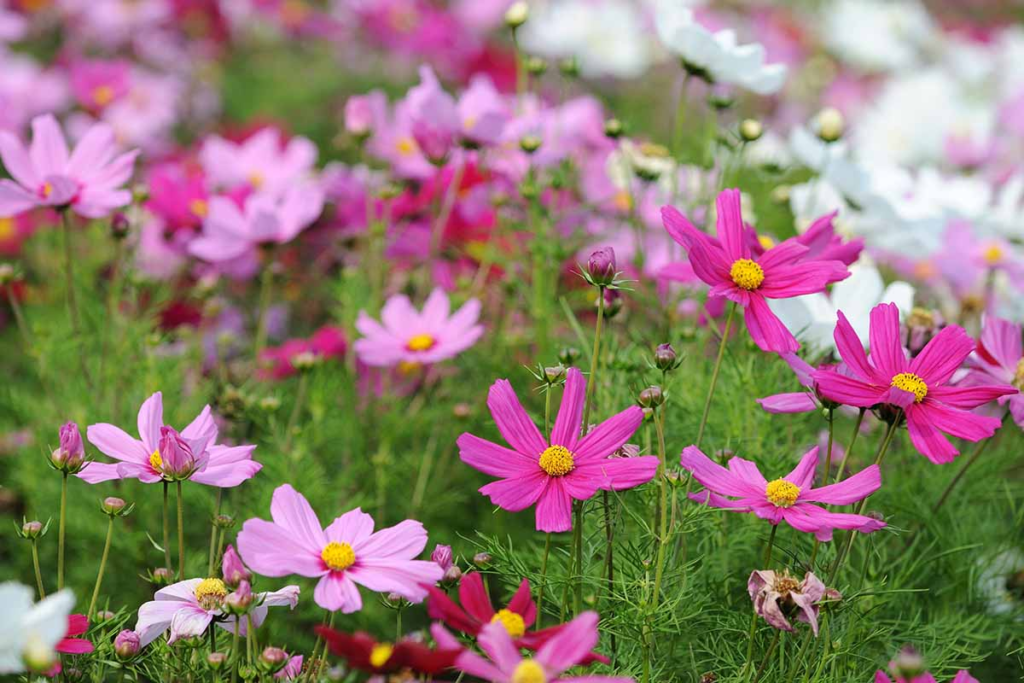
9. The Edible and Ornamental Integration: Beauty You Can Eat
While cosmos and zinnias are grown primarily as ornamental plants, both have connections to the edible garden that make them perfect candidates for integrated plantings that are both beautiful and productive. Zinnias have edible petals that can be used as colorful garnishes in salads and summer drinks, while cosmos serve as excellent companion plants for many vegetables, attracting beneficial insects that help control garden pests.
According to the USDA’s Agricultural Marketing Service, the trend toward edible landscaping continues to grow as more Americans seek to maximize the productivity of their home gardens while maintaining aesthetic appeal.
Here’s how to create an integrated edible and ornamental garden featuring cosmos and zinnias:
Use cosmos and zinnias as decorative borders around vegetable beds. Their vertical growth and abundant blooms create living “fences” that define spaces while performing valuable ecological services. The strong stems of zinnias, in particular, can serve as natural supports for lightweight vegetable plants like bush beans or young pea vines.
Plant cosmos and zinnias directly among vegetables as beneficial companions:
| Vegetable | Flower Companion | Benefit |
|---|---|---|
| Tomatoes | Tall cosmos | Attracts parasitic wasps that control tomato hornworms |
| Cucumbers | Zinnia ‘Profusion’ series | Draws pollinators for improved fruit set |
| Kale/Broccoli | Cosmos ‘Sensation’ | Distracts cabbage white butterflies from crops |
| Eggplant | Zinnia ‘Zahara’ series | Attracts ladybugs that eat aphids |
Create dedicated cutting beds adjacent to vegetable gardens for easy harvest. This proximity allows you to gather flowers for the table while picking vegetables for dinner—bringing beauty indoors along with your homegrown produce.
Incorporate cosmos and zinnias into herb spirals or keyhole gardens. These space-efficient designs blend ornamental and culinary plants in attractive, accessible arrangements that make garden maintenance and harvesting more convenient.
Consider these additional edible companions that share similar growing requirements with cosmos and zinnias:
- Culinary herbs like basil, dill, and cilantro (which can be allowed to flower alongside your ornamentals)
- Edible flowers such as nasturtiums, calendula, and borage
- Colorful vegetables that double as ornamentals, like ‘Bright Lights’ Swiss chard or purple bush beans
For those interested in using zinnia petals in culinary applications, remember these guidelines:
- Only use flowers grown without pesticides or chemical fertilizers
- Remove the petals from the flower base, as the center can be bitter
- Introduce edible flowers into your diet gradually, as some people may have sensitivities
- Use petals primarily as garnishes rather than main ingredients
By combining the ornamental virtues of cosmos and zinnias with productive edible plants, you’ll create a garden that nourishes both body and soul—providing fresh produce for your table and abundant beauty for your enjoyment.
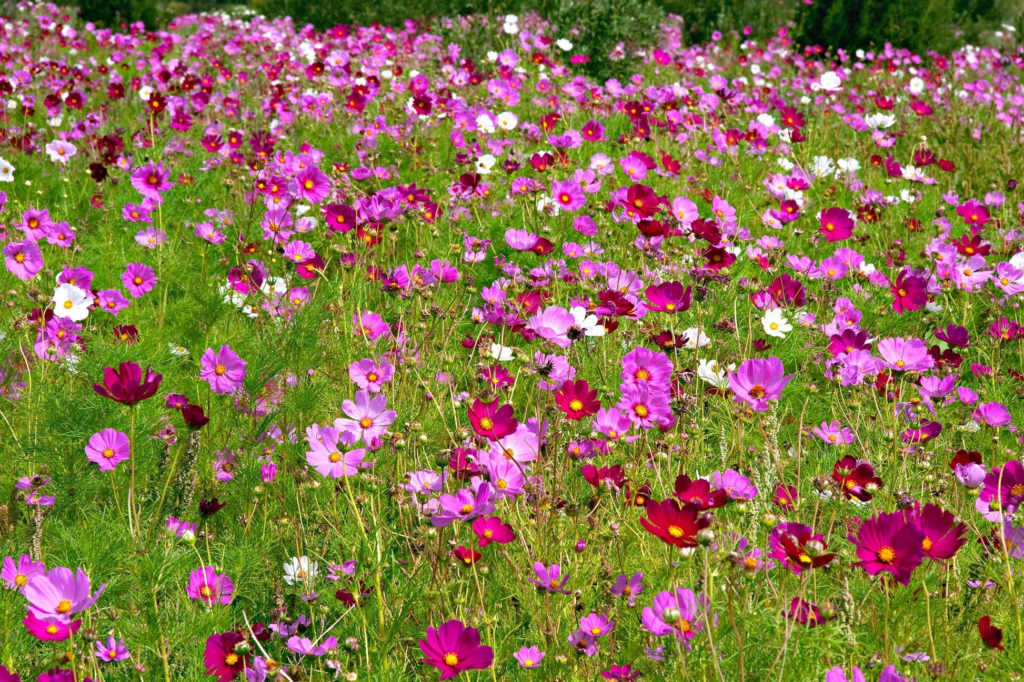
10. The Low-Maintenance Landscape: Beauty Without the Burden
Perhaps the most compelling reason to incorporate cosmos and zinnias into your garden is their exceptional ease of care. For busy homeowners, new gardeners, or anyone who wants maximum beauty with minimum effort, these flowering powerhouses deliver reliable performance with remarkably little maintenance.
The USDA Forest Service advocates for low-maintenance landscaping approaches that conserve resources while creating beautiful, functional outdoor spaces. Cosmos and zinnias exemplify these principles while providing months of vibrant color.
To create the ultimate low-maintenance landscape featuring these easy-care annuals:
Start with proper site preparation. Taking time to prepare your soil, remove perennial weeds, and incorporate moderate amounts of organic matter before planting will significantly reduce maintenance throughout the growing season. For truly minimal effort, consider laying cardboard or several layers of newspaper over your planting area in fall or early spring, topping with 4-6 inches of compost or garden soil, and planting directly into this weed-suppressing layer.
Select disease-resistant varieties that require less intervention:
Low-Maintenance Cosmos:
- ‘Sonata’ series (compact growth, less staking required)
- ‘Apollo’ series (early blooming, disease-resistant)
- ‘Cosmic’ series (dwarf plants that rarely need support)
Low-Maintenance Zinnias:
- ‘Profusion’ series (highly disease-resistant, self-cleaning)
- ‘Zahara’ series (exceptional mildew resistance)
- ‘Magellan’ series (compact plants that rarely need staking)
Implement these labor-saving strategies:
- Mulch thoroughly after planting to suppress weeds and conserve moisture
- Install simple drip irrigation or soaker hoses with timers for hands-off watering
- Plant in blocks rather than individual specimens for easier maintenance and stronger visual impact
- Choose varieties that don’t require deadheading (like ‘Profusion’ zinnias) or limit deadheading to once weekly
- Embrace some natural wildness rather than striving for perfect garden “control”
Consider a simplified approach to the end of the season as well. Rather than removing spent plants in fall, allow them to stand through winter, providing visual interest, seed for birds, and habitat for beneficial insects. Simply cut and compost the previous year’s growth when preparing to plant anew in spring.
For those who travel frequently or have limited time for garden maintenance, cosmos and zinnias are particularly valuable. They can endure a week or two of neglect during summer vacations and quickly recover once regular care resumes—a claim many garden plants cannot make.
The beauty of this low-maintenance approach lies not just in the time saved but in the garden’s resilience. By selecting the right plants for your conditions and implementing smart design principles, you create a landscape that thrives despite (or even because of) a more hands-off approach.
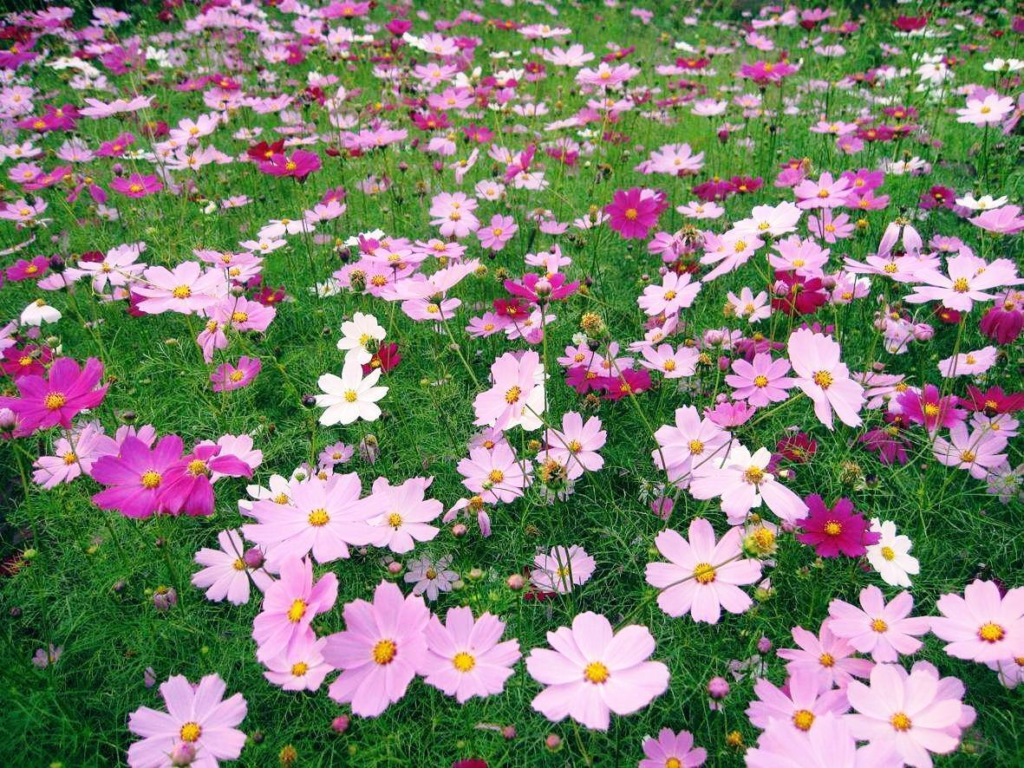
Conclusion: Your Personal Paradise of Color
As we’ve explored throughout this guide, cosmos and zinnias offer unparalleled versatility for home gardeners seeking abundant color with minimal effort. Whether you have acres of land or just a few containers on a balcony, these flowering champions can transform your outdoor space into a haven of beauty that rewards you from summer through fall.
By implementing even a few of the ideas presented here—from cottage gardens to cutting gardens, drought-tolerant displays to edible integrations—you’ll discover the joy these flowers bring to both your landscape and your life. Their ability to attract pollinators, provide cut flowers for your home, and create months of changing color makes them truly exceptional additions to any garden.
Remember that gardening is ultimately a personal expression, so feel free to adapt these suggestions to your unique situation, preferences, and climate. The forgiving nature of cosmos and zinnias means that even experimental approaches are likely to yield beautiful results.
As you plan your garden this season, consider giving these flowering companions pride of place in your landscape. Their combination of effortless care and extraordinary beauty represents gardening at its most rewarding—where minimal investment yields maximum joy, bringing both your garden and your spirits into full bloom.
Whether you’re seeking a pollinator paradise, a cutting garden for endless bouquets, or simply an easy-care landscape of reliable color, cosmos and zinnias deliver on their promise of effortless beauty season after season.
